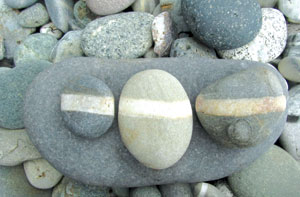July/August 2014
The Lucky Striped Beach Stones on Eagle Island
 “What you have collected are various examples and sizes of different white quartz ‘veins,’ not tubes like real veins but narrow fractures or cracks in the rocks. During the bulldozer-like plate collision that built this part of the Appalachian Mountains 400 to300 million years ago… the deep root of the thickened mountain crust warms up and first dehydrates where minerals that have water in their crustal structure convert to higher temperature minerals that don’t, give up their water in an upward streaming flow, that finds the crack ways to rush the hydrothermal waters, solutions carrying lots of available Silicon (all the rocks it passes through are silicate minerals so a lot of Si gets dissolved in the hot water). As the hot hydrothermal fluids rise to shallower levels in the crust, working through the available brittle fractures, they cool and can’t hold as much Si in solution at the lower temperature so very quickly massive amounts of Si and O drop out, forming quartz.
“What you have collected are various examples and sizes of different white quartz ‘veins,’ not tubes like real veins but narrow fractures or cracks in the rocks. During the bulldozer-like plate collision that built this part of the Appalachian Mountains 400 to300 million years ago… the deep root of the thickened mountain crust warms up and first dehydrates where minerals that have water in their crustal structure convert to higher temperature minerals that don’t, give up their water in an upward streaming flow, that finds the crack ways to rush the hydrothermal waters, solutions carrying lots of available Silicon (all the rocks it passes through are silicate minerals so a lot of Si gets dissolved in the hot water). As the hot hydrothermal fluids rise to shallower levels in the crust, working through the available brittle fractures, they cool and can’t hold as much Si in solution at the lower temperature so very quickly massive amounts of Si and O drop out, forming quartz.
“So fast is this happening that the quartz never gets a chance to finish every spot in the rapidly developing crustal structure, so the missing spots are taken up by trapped water which, and because there are so many of these fluid inclusions, the quartz appears white and opaque, whereas well-formed crystals are clear. The growth of this quartz occurs rapidly, over several months, completely sealing off the fracture and the former fluid pathway. But the rise of fluid is relentless and the building of this backed up fluid pressure is enough to fracture rock leading to fresh pathways for rising fluid to cool and seal with quartz again in a continuous ‘crack and seal’ process.
“Later–maybe 10,000 years ago or maybe even younger–when the mountains are eroded away to the bare nub they are today, the interior of these older mountians is now exposed where the old mountain rock is crossed by these older filled fracture quartz veins. Chunks of this get broken up by glaciers perhaps, or shoreline processes, and then these fragments get rounded by wave action to what you have today.
“So the ring is actually just a segment of the former planar fractured-filled quartz vein. It looks like a ring , but if you hold it just right you can see that the white is very straight and planar. If the rounding continues you will eventually remove the oter rocks and you will be left with a pure white quartz round pebble, form inside one of these former quartz veins.
“Lucky? You would think after 300 to 400 million years and you just stumble upon it? Sounds lucky to me.
“And if you are really lucky, you can find white quartz veins that have been re-fractured and recemented by more usually darker quartz to form pebbles and cobbles with this amazing shatter texture, likely fault-related.
“Way more that you really wanted to know I’m sure, but those little white ringed pebbles have quite a story.”
Mark Swanson, PhD
Professor of Geosciences
USM





0 Comments